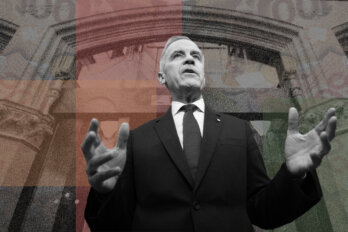It’s mid-July 2018 and the heat is merciless. The speaker, a middle-aged man with a patchy beard, stands on Parliament Hill atop a makeshift stage of three stacked pallets, microphone in hand. “I’m proud to stand here with a bunch of real Canadians who stand up for real values,” he says.
Meet Colin Saunders, field officer of the Canadian Coalition for Firearm Rights (CCFR). Canada’s youngest gun lobby group, the CCFR formed in 2015 to fill a unique niche as “the public relations arm of the Canadian firearms community.” The new group splintered off from the National Firearms Association—Canada’s oldest gun lobby, dating from the 1970s—and has promised to act as a “sophisticated, disciplined,” nonpartisan voice promoting gun ownership, with a policy wish list that includes concealed handgun licensing, firearm-friendly self-defence laws, and the legalization of machine guns. The CCFR has a policy of not releasing its membership numbers, even to members, but has claimed a 67 percent membership growth this year.
Since its launch, the CCFR has been busy. Thanks in part to an active social-media presence (members are heavy users of Twitter and Facebook, and the group has a YouTube channel where it posts new videos weekly to some 13,000 subscribers), it has become Canada’s most prominent pro-gun group. A Liberal fundraising email in 2018 called it “Canada’s NRA.” In 2018, the CCFR held two press conferences in Centre Block, the main building of Parliament. It has also expanded its activities to include directly lobbying the government, and claims to employ the country’s only full-time, in-house gun lobbyist, Tracey Wilson. Wilson—who is also Saunders’ fiancée—meets with members of Parliament, testifies before House and Senate committees, and speaks to media, all to protect the interests of Canadian gun owners.
But the small crowd of about forty gathered that July day to protest Justin Trudeau’s government wasn’t there on behalf of gun owners. The “proud, real” Canadians who organized this rally and offer Saunders occasional ragged cheers are members and supporters of the Canadian Combat Coalition (or “C3”), which experts consider an anti-Muslim hate group.
According to its Facebook page, C3 opposes “mass immigration, open borders, New World Order and Sharia Law.” Like similar groups that have sprung up in recent years—Yellow Vests Canada, PEGIDA Canada, and the Worldwide Coalition Against Islam—C3 exploits anti-Trudeau sentiment to recruit new members on Facebook, offering an alternative worldview in which a traitorous government conspires to bring about the Islamification of Canada.
Among the speakers at C3’s July 2018 “Canadians for Canada” rally was Kevin Johnston, who recently made the news by losing a $2.5 million libel suit over a series of Islamophobic videos described by a judge as “a loathsome example of hate speech at its worst.” C3’s leaders insist the group is not racist.
No one from the CCFR, including Wilson, Saunders, and CEO Rod Giltaca, responded to interview requests for this article. But the troubling story of the organization’s politics can be corroborated by the public relationships its members have maintained, both online and off. Why would the CCFR associate with C3 or speak at one of its rallies? Why not disavow it? In a word: audience.
With nearly 4,000 angry right-wing minds eager to latch onto a new cause, C3 is a natural constituency for Saunders and his organization. In return, C3 gets legitimacy. Canada’s far right tends to be composed of fringe players struggling to get the attention of an inaccessible elite; to attract a speaker like Saunders, who represents a group with access to that elite, is a victory. CCFR lobbyist Wilson is a friend of Conservative MP Michelle Rempel and recently attended her wedding. At that event, Saunders was photographed with Stephen Harper. According to Evan Balgord, executive director of the Canadian Anti-Hate Network, proximity to mainstream politics is what most far-right groups crave. “That’s a huge shot in the arm for them,” he says. “It gives them some credibility to the media. It gives them credibility within themselves. They think they’re making an impact, and it fires them up.”
The main goal for much of the extreme right, according to Balgord, is to shift the political norms that sideline white nationalism. “One thing the alt-right gets correct is that we’re fighting a cultural war, and politics is downstream of societal norms,” he says. If legitimate lobby groups like the CCFR can consort with extremists without consequence, then topics such as “securing the future of the white race” edge closer to becoming valid concerns for public debate.
In essence, C3 is trading its willing audience for an association that helps normalize hate. The CCFR, eager to expand its reach, has taken the deal.
Colin Saunders’ involvement with C3 appears to have begun while he was organizing a “Veterans Left Out in the Cold” protest held February 15, 2018, on Parliament Hill. Rick Boswick, then vice president of C3, promoted the protest by sharing Saunders’ videos to C3’s Facebook group, starting in late January. On February 7, C3’s Ontario president Dan Unrau added Saunders to the Canadian Combat Coalition National Facebook group. In an April 30 tweet, Saunders claimed to not be a member of C3 but seemed to have appreciated their “support.”
Boswick and his sidekick Derek Storie, who style themselves “domestic war reporters,” are well-known figures on Canada’s far right. They were among a group of men who burned a Quran during a PEGIDA Canada rally in Toronto on May 4. On June 15, they recorded a man, later identified by an anti-hate group as Chris Vanderweide, smashing supporters of Hamilton’s pride celebrations in the face with a helmet and celebrated him on social media as a hero (in July, Vanderweide was charged by police with two counts of assault with a weapon). One week after the Hamilton violence, they recorded a second brawl, in the Eaton Centre, following a protest against Toronto’s pride celebrations (in that recording, Boswick can be heard shouting encouragements like “fuck him up.”) On April 28, they interviewed noted white supremacist Paul Fromm. C3’s politics are no secret.
The veterans’ protest was a success—not only for Saunders, who, as a retired sergeant in the Canadian Armed Forces, hoped to draw attention to veterans’ issues, but also for Boswick, who posted an enthusiastic report to C3’s Facebook group. “A Stellar event,” Boswick wrote. He boasted that he and Saunders had met with Opposition MPs and had been invited to witness Question Period (Question Period is always open to the public). In Saunders, Boswick had gained what the fringe craves: a credible ally.
Saunders’ interest in far-right groups was not new. In November 2017, I noticed that he was a member of the III% Ontario Patriots closed Facebook group, which is now defunct. (III% militias are armed right-wing organizations; the name alludes to the American Revolution.) On April 28, during a Twitter conversation regarding possible links between the gun lobby and right-wing extremism, I mentioned that Saunders was a member of C3’s Facebook group. This revelation prompted a flurry of tweets from Wilson asserting that Saunders is not a “racist white supremacist.”
Wilson claimed that Saunders had been added to hundreds of Facebook groups with topics ranging from Tupperware to autism, and that he had been added to the C3 group without his knowledge. But according to Facebook, a person can’t appear in a group’s members list until they have accepted the invitation to join. Saunders’ most recent comment in the C3 group was on April 18, when he greeted C3 leader Dan Dubois as “brother.”
“I literally have never even heard of that group,” Wilson tweeted. But video of Saunders’ speech at the July 2018 C3 rally, which he posted to Facebook, tells us otherwise: Wilson peers over her sunglasses at her phone’s front-facing camera before switching it to record Saunders. There is Tracey Wilson; there is Colin Saunders; and there, as the camera pans right, is a Canadian Combat Coalition banner.
Saunders is not known to have posted any overtly hateful content to C3’s Facebook group. He did not mention Islam in his speech at the 2018 “Canadians for Canada” rally, devoting it instead to guns, crime, and veterans’ issues. Saunders’s own Facebook and Twitter accounts, however, reflect right-wing fears of globalization, immigration, and terrorism; on Facebook, he shared a blog post by Pamela Geller, the American author of Stop the Islamization of America, which declared that Bill C-75—intended to streamline the criminal justice system with time limits on prosecutions—was meant to “accommodate Muslim crimes.” Saunders did not respond to my request for an interview. But within twenty-four hours of that request, he posted to Twitter and Facebook a short statement saying, “There is no place for intolerance, racism, or extremism in Canada . . . period.”
Saunders remains a member of the Canadian Combat Coalition National Facebook group.
Canadians own guns for legitimate reasons, and advocacy groups inevitably spring up to defend their interests. But the rise of far-right extremism and its spread through social media pose a serious challenge for firearms advocates: How to protect your own credibility when hate groups keep promoting your cause?
On June 2, the Prairie Freedom Movement—a western separatist group that does not shy from bashing Islam and immigration—held a “Stick to Your Guns” rally in Calgary to protest gun control. According to a report by the Toronto Star, among the forty-odd attendees were members of the Northern Guard, a militant, men-only, anti-Muslim organization. Guns and veterans are important symbols to the far right, and by sharing pro-gun and pro-veteran content—as C3 frequently does—hate groups broaden their appeal, hoping to pull conservative readers in.
The gun rights movement is so deeply invested in the idea that all gun owners must stick together that it has proven unwilling to turn away any support. The CCFR has taken this a step further, openly courting fringe right-wing support. In turn, the fringe right uses the CCFR’s mainstream credentials to break down norms and recruit followers.
The CCFR’s flirtation with extremists is not limited to Wilson and Saunders. CCFR CEO Rod Giltaca presents a reasonable face in mainstream media interviews, insisting that gun owners are responsible, ordinary Canadians. But Giltaca has also given interviews to YouTube conspiracy theorist channel “Press for Truth,” which pushes chemtrail conspiracy theories, straight pride, and transphobia. In early June, YouTube demonetized the channel: Press for Truth would no longer be eligible to receive ad revenue because the platform deemed its content to be “incendiary, demeaning, or promoting violence or hatred.”
To Bernie Farber, chair of the Canadian Anti-Hate Network, the CCFR’s dalliance with the right-wing fringe is frightening, if only because the CCFR’s leadership will not disavow the racist right. “There are people Giltaca surrounds himself with, who are involved with his organization, who don’t take umbrage with it,” Farber says. “And the very fact that they don’t scares me as much as anything else.”
The messages the far right push aren’t harmless. Justin Bourque, whose Facebook timeline in the weeks leading up to the 2015 Moncton RCMP shooting was a mess of pro-firearms content and anti-authoritarian conspiracy theories, stepped out of his front door hoping to inspire a revolution against the police. Alexandre Bissonnette’s murderous Islamophobia was learned; it gave us the 2017 Quebec City mosque shooting. The March 2019 Christchurch massacre could well have happened here. Statistics Canada reports that hate crime is rising. Violence from the fringe right is no longer a hypothesis.
Norms matter. Guns and hate are a lethal mix, and the rules that make hate speech unacceptable must be preserved. If Canada’s leading firearms lobby is unwilling to distance itself from the right-wing fringe—a group that believes, among other things, that they must be armed to resist an Islamic takeover of Canada—then Canadians ought to take notice.





